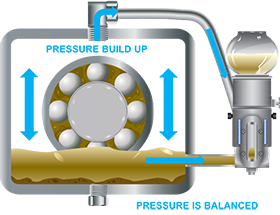
Mike Gauthier
10.01.2019
Oil Intelligence May Reveal That These Machine Components Are Causing Trouble
If oil analysis is showing particulate or water contamination of your machine lubricant, one of the key places to look is the technical specs related to the equipment. The details of what’s in and on the machine often shed some light on possible contamination causes.
Exhibit A: vented constant level oilers. As reliable as constant level oilers have been over the years at maintaining the right level of lubricant, the truth is the conventional vented style may not be right for some applications.
Especially in harsh environments and high-output operations, any venting leaves an opening for ingression of moisture and particulates into equipment lubricant. And that can lead to potential issues.
Experts Estimate Preventing Contamination Costs about 10% of Removal
Consider that:
- ~40% of rotating equipment failure is due to bearing failure.
- ~80% of those failures are directly attributable to lubrication problems including contamination through vents/breathers.
So, is it time for your plant to upgrade your oiler approach? Possibly, depending on factors related to your process, conditions in your facility and other factors. Let’s take a closer look at open (vented) oilers vs. closed (unvented) systems.
Pressure Balancing with Vented Constant Level Oilers
Gearboxes, pumps and reservoirs need to “breathe,” equalizing pressure when air expands and contracts due to temperature fluctuations or startup/shutdown situations.
If you’re using a vented oiler, it’s important to vent the bearing housing, as well, through the fill port. Air pressure balancing will take the path of least resistance through the vent, leaving the oiler unaffected.
However, to catch any contaminant ingression, you should vent the housing with a check-valve style desiccant breather (such as the Watchdog®) instead of a traditional vent, j-tube or air filter.
What about Using a Vented Oiler with a Labyrinth Seal or Bearing Isolator?
There’s a misconception in many industries that a vented oiler should not be used with labyrinth-style shaft seals. This is NOT TRUE. Here’s why:
Some shaft seals are supposed to allow the housing to breathe. A “dynamic” O-ring is designed to rise by centrifugal force to open an air path. However, it doesn’t always work that way. Because of compatibility, temperature, swelling or sticking, the O-ring does not open the air path.
If the air can’t vent out of the housing, the pressure rises inside, forcing fluid back out of the vented oiler.
So what should you do to prevent this issue? Unfortunately, the most common recommendation from seal manufacturers and distributors is to take the oiler off – even though the real problem is the O-ring.
Why forfeit the reliability assurance provided by the oiler to solve a problem that isn’t caused by the oiler? Instead, the pressure can be balanced simply and effectively by placing a desiccant breather in the top port of the housing.
Considering the Newer Alternative of a Closed System
Rather than the vented oiler/desiccant breather setup, which still has the potential for contaminant ingression through the oiler vent, you could switch to a closed system. In this setup, a pressure balancing line between the housing and the oiler allows the housing to breathe – regardless of whether the seal is working properly.
By getting rid of the vents and including a desiccant breather on the housing, the closed system virtually eliminates the threat of external contamination – potentially making a big difference in your plant.

It Pays to Be Open Minded about Closed Systems. Just Ask These Plants:
- A paper mill cut its oil changes in half, saving $165K over five years on oil changes alone.
- A chemical plant saved $210,000 over two years.
That’s without even considering the savings on repairs and downtime.
So, here’s a question: Have you or your supplier taken the steps to upgrade your shaft seals from the old packing seal or leaky lip seal to bearing isolators? Knowing what it could mean to your plant, why wouldn’t you take the same forward-thinking approach to your constant level oiler?
As we said before, any number of factors in your plant, your practices and your process may actually cause contamination of your critical equipment lubrication. But if you’re serious about getting more life out of your components and equipment, you should consider closing every potential point of contamination ingression. This one simple step could potentially save you thousands of dollars related to contamination issues.
Do You Have an Ingression Issue?
The Trico team can help you find out.







